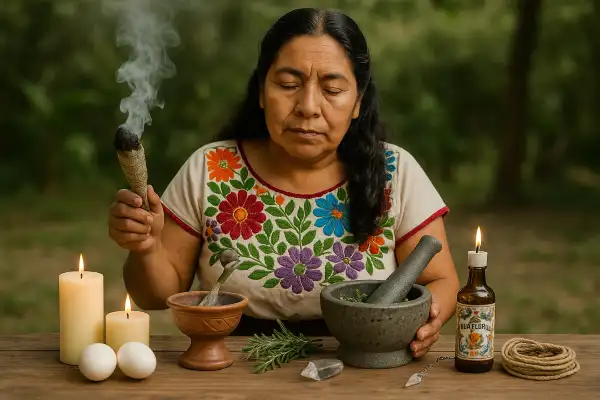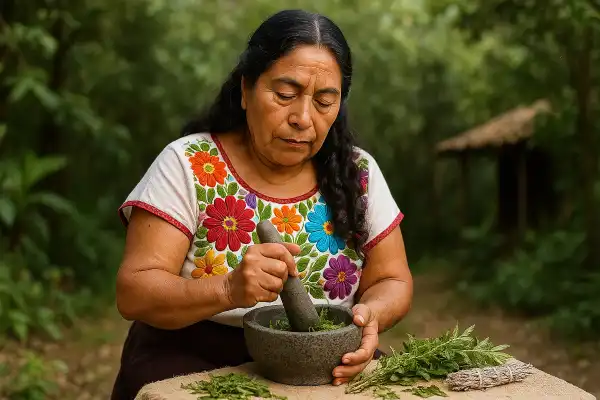The tools used in curanderismo represent far more than simple instruments—they embody the sacred connection between healer, patient, and the natural world. Many people seek to understand these ancestral implements because they recognize the profound healing that emerges when we honor both the physical and spiritual dimensions of wellness.
María del Pilar Fernández believes deeply in preserving these traditional healing arts for future generations. Drawing from her family’s curandera lineage in Oaxaca, she approaches the tools used in curanderismo with the reverence they deserve, understanding that each instrument carries the wisdom of countless healers who have walked this path before us.
Tools used in curanderismo
The most important tool in any curandero’s practice is the heart, as the tangible implements are symbols of the healer’s spiritual faith and relationship to Mother Earth. The sacred instruments of curanderismo work in harmony to restore balance between body, mind, and spirit, each serving a specific purpose in the ancient art of healing.
Copal: The sacred resin
Copal, an aromatic incense collected by traditional harvesters from the Bursera tree in Mexico, opens every curanderismo session with purifying and calming smoke. This golden resin has been sacred to indigenous Mesoamerican cultures for thousands of years. Large amounts of copal incense were burned on top of Aztec and Mayan pyramids, and the word copal derives from the Nahuatl language word copalli, meaning “incense.”

For limpias (energy cleansings), copal resin is burned to make purifying smoke, creating a sacred atmosphere that prepares both healer and patient for spiritual work. Copal removes and transmutes negative energies of all kinds, joining the powerful energy of the sun with the transmutative properties of the Earth. The fragrant smoke helps clear stagnant energy and opens the crown chakra, facilitating deeper spiritual connection during healing sessions.
Eggs: Nature’s energy absorbers
The egg is undoubtedly the quintessential item used in curanderismo, according to anthropologist Anthony Zavaleta who has studied the practice for over 50 years. The egg’s popularity in holistic healing dates back thousands of years and can be found in old texts from Greek and Roman times.
The egg cleansing ceremony serves to cleanse the spirit and discover and remove the Evil Eye if present. During a limpia, the egg is used as a psychic vacuum cleaner, rubbed all over the body to pull off negative energy, cords, and move stuck emotions. The raw state of the egg has a natural ability to absorb negativity, and when combined with special prayers, makes the limpia very effective.
After the cleansing, the egg is cracked in a glass with water and other ingredients, allowing the curandero to examine the results and determine if evil eye is present, if guardians are protecting the person, or if there may be physical health problems. The patterns formed by the egg white, yolk positioning, and any unusual formations provide diagnostic information about the patient’s energetic state.
Sacred herbs: Earth’s medicine
No matter what specialty curanderas had, all of them had some knowledge of herbs and medicinal plants. The plant kingdom provides powerful allies for both physical and spiritual healing, each herb carrying its own unique properties and purposes.

Ruda (Rue) stands as one of the most important protective herbs in curanderismo. Primarily used as an anti-evil charm and general spiritual curative, it can also bring prosperity and wealth. Ruda is commonly used for limpias and barridas (sweeping ceremonies).
Romero (Rosemary) serves multiple purposes in traditional healing. Romero is one of the most common medicinal plants used then and still used today. This aromatic herb provides protection, mental clarity, and purification during spiritual work.
Albahaca (Basil) brings peace and harmony to healing spaces. Albahaca or alucema (basil) is commonly used for limpias and helps create an atmosphere of tranquility during sessions.
Pirul (Pepper tree) and sábila (aloe vera) round out the essential herbal toolkit, representing medicinal plants that were used then and are still used today. These herbs can be bundled into brooms for barridas, brewed into healing teas, or burned as purifying smoke.
Feathers and natural elements
Natural elements are brought into physical healing with the use of feathers, rocks, crystals and wood. Feathers, particularly those from sacred birds, help direct energy and cleanse the auric field. They serve as extensions of the healer’s intention, gently brushing away negative energies while invoking the power of air and spirit.
Crystals and stones ground healing energy and provide stability during intense spiritual work. Crystals are often placed around the body during a cleansing ceremony to absorb negative energy and promote healing. Each stone carries specific vibrations that support different aspects of healing—from protection to emotional balance.
Sacred candles
Saint candles are common, but so are candles frequently found in other traditions, from cleansing to simple prayers. Candles with pictures of saints, religious statues, flowers and herbs are included in altars that contain symbols of the four elements—earth, water, fire and air.
Different colored candles serve specific purposes: white for purification and spiritual connection, red for strength and protection, green for healing and prosperity, and blue for peace and communication. The flame represents the presence of spirit and provides a focal point for prayers and intentions.
Water and salt
Water holds prayers and intentions, serving as both a cleansing agent and a medium for reading energetic patterns. Naturally fertilized or organic eggs, salt, cornmeal, water and soil are also used for limpias. Salt, particularly sea salt, provides powerful protection and purification, creating sacred boundaries and neutralizing negative energies.
Mezcal and blessed waters
Mezcal, an alcoholic spirit derived from the Agave plant, is sprayed over the head, heart, stomach, hands, and feet. According to traditional knowledge, mezcal is a spiritual drink used to return the spirit to the body. Various blessed waters, often collected from sacred sites or blessed by spiritual authorities, provide additional layers of protection and healing.
The healer’s altar
Altars contain symbols of the four elements—earth, water, fire and air—and other articles illustrative of forces called upon to assist in healing. The altar serves as a sacred workspace where tools are blessed and energized. Everything in the curandero’s healing practice and lifestyle is infused with a relationship to nature and God.
These tools work together in harmony, each supporting the others in creating a complete healing experience. The true power lies not in the objects themselves, but in the sacred intention, cultural knowledge, and spiritual connection that the curandero brings to their use. Each curandera and curandero has a distinctive practice that is most often learned within the context of their family, community, and elders.
Understanding these tools helps us appreciate the depth and sophistication of this ancient healing system, where physical, emotional, and spiritual wellness are addressed as interconnected aspects of human health. Through respectful use of these sacred instruments, the healing arts of our ancestors continue to serve contemporary communities seeking holistic wellness.
Disclaimer
Please note that Maria is not a physician, psychologist, or nurse. These culture-specific spiritual healing services are not meant to replace medical or psychological diagnosis and treatment. It is recommended that you see a licensed physician or licensed health care professional for any physical or psychological ailment you may have.
I remember when Daniela came to me carrying the weight of generations. This young woman from Guadalajara had moved to the United States three years prior, leaving behind not only her homeland but also her sense of belonging. She described feeling as though part of her soul had remained in Mexico while her body existed in this new country—a condition our ancestors call “soul loss.”
During our session, I arranged my healing tools with careful intention: fresh sprigs of romero and ruda bundled together, a white egg that had been blessed under the full moon, copal resin waiting to be lit, and a special candle dedicated to Nuestra Señora de Guadalupe. After opening with prayer and the purifying smoke of copal, I began the limpia by gently sweeping Daniela’s body with the herb bundle, working from crown to feet while calling her spirit back home to her heart.
The egg cleansing revealed what I suspected—patterns in the water showing disconnection and longing. Through breathwork, further cleansing with blessed water, and the gentle guidance of ancestral wisdom, Daniela began to feel whole again. By the end of our session, tears of relief flowed as she recognized that she could carry her homeland within her heart while still embracing her new life. The tools had served their purpose, facilitating the reunion of spirit with body that our healing tradition knows so well.
